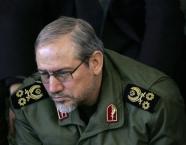 American officials like to say that Iran’s defiance of international demands that it limit its nuclear activities, its support for terrorism, and the like have led to Tehran’s growing isolation. Iranian regime officials see things differently. The Iranian regime has a strategy in the Middle East and believes it is succeeding.
American officials like to say that Iran’s defiance of international demands that it limit its nuclear activities, its support for terrorism, and the like have led to Tehran’s growing isolation. Iranian regime officials see things differently. The Iranian regime has a strategy in the Middle East and believes it is succeeding.
Nowhere in the Middle East is Iran’s strategy clearer at the moment than in Syria. Recently, Maj. Gen. Yahya Rahim Safavi, the military advisor to Iran’s supreme leader, asserted that Syria is a “confrontation between the strategic policies of the world’s great powers and regional powers,” with Iran and its foreign allies on one side, and the United States and its regional allies on the other, per a translation by the American Enterprise Institute.
In explaining why Iran is engaged in this confrontation, Safavi noted that “Iran has pursued power and influence out to the Mediterranean three times.” Two of these instances, in Safavi’s recounting, occurred during the reigns of ancient Iranian kings. The third, however, was the present. He explained that Iran currently uses Hezbollah as “the long arm of Iranian defensive power … to confront a possible Zionist attack against Iran’s nuclear energy facilities.”
Safavi also explained how successful Iranian approaches to Iraq and Afghanistan, as well as to Syria, have made Iran a “regional power” in defiance of Western efforts to thwart its ambitions.
It would be easy to dismiss Safavi’s claims as bluster. They are certainly selective: Ordinary Iranians are unlikely to find much comfort in his claimed foreign-policy successes while they struggle with rising inflation and unemployment at home. As hyperbolic as his claims may be, however, they are echoed by other Iranian officials and provide a useful guide to understanding Iranian actions and formulating an approach to the region.
Western officials and analysts have a tendency to artificially isolate one problem in the Middle East from another, treating Iran’s nuclear program and the Syrian crisis, for example, as distinct problems to be dealt with independently.
This can lead to clouded analysis and false policy choices. For example, some argue that the United States should avoid involvement in Syria to ensure that resources are available to deal with Iran. In reality, both Iran’s activities in Syria and its nuclear ambitions are part of a broader Iranian strategy to project power, enhance its regional influence, and constrain the United States and its regional allies.
Likewise, many analysts were surprised by Hezbollah’s open admission of its deep involvement in Syria, because they viewed the group as primarily a Lebanese political party or as engaged in fighting Israel. While both of these are true, they neglect that Hezbollah is more fundamentally a group created to project Iranian power into the Levant, a mission with which its Syrian venture — as well as its activities in Iraq during the last decade — is perfectly compatible.
Western officials’ inattention to this broader picture has real strategic consequences for U.S. interests. No matter how much American policymakers stress that the “military option” is on the table with respect to Iran’s nuclear program, Washington’s failure to push back on Iranian aggression in Syria, and the European Union’s reluctance to penalize Hezbollah for its actions, undercut the credibility of Western warnings. Whatever the view of the West, for Tehran these issues, as well as the West’s responses to them, are inextricably connected.
And not just for Tehran — America’s allies in the region also see U.S. actions in different theaters as linked, and they view with alarm Washington’s passivity in the region. Consequently, American influence is everywhere diminished as friends and foes alike increasingly factor Washington out of policy decisions, and the force of America’s allies collectively is reduced as each pursues policies independently not just of the United States but, to a great extent, of one another.
Once lost, influence is costly to regain, which gives rise to a vicious cycle. Re-establishing U.S. influence and credibility requires actions that, as crises deepen and multiply, become costlier as time passes, which reinforces the argument against taking them. Nowhere is this more evident than in Syria.
Costly interventions in Iraq and Afghanistan have soured U.S. officials on further entanglement in the Middle East. But disengaging from the region will only add to the costs of those wars, not compensate for them.
One lesson we must learn from those conflicts, however, is to have clear objectives and to pursue them economically. When it comes to Iran, the objective has never been and should not become merely limiting Iranian nuclear activities, but disrupting the strategy of which both the nuclear program and Syria, as well as Iran’s asymmetric actions, are parts. A non-nuclear Iran emboldened by victory in Syria remains dangerous.
The economical way to begin countering Iran’s strategy is not to wait for a last-resort strike on Iranian nuclear facilities, or worse yet to continue offering Iran nuclear concessions in hopes it will bite; rather, it is to press Iran in a place like Syria, where it is far from home and perhaps overextended.
Defeating Iranian designs in Syria will not halt Tehran’s nuclear ambitions, but it may restore in the eyes of Iranian and allied officials alike the credibility of American power, and force Tehran to reconsider the costs of its strategy. For Iran, Major General Safavi reminds us, has a strategy in the Middle East; the United States must as well.
FP
Leave a Reply
You must be logged in to post a comment.